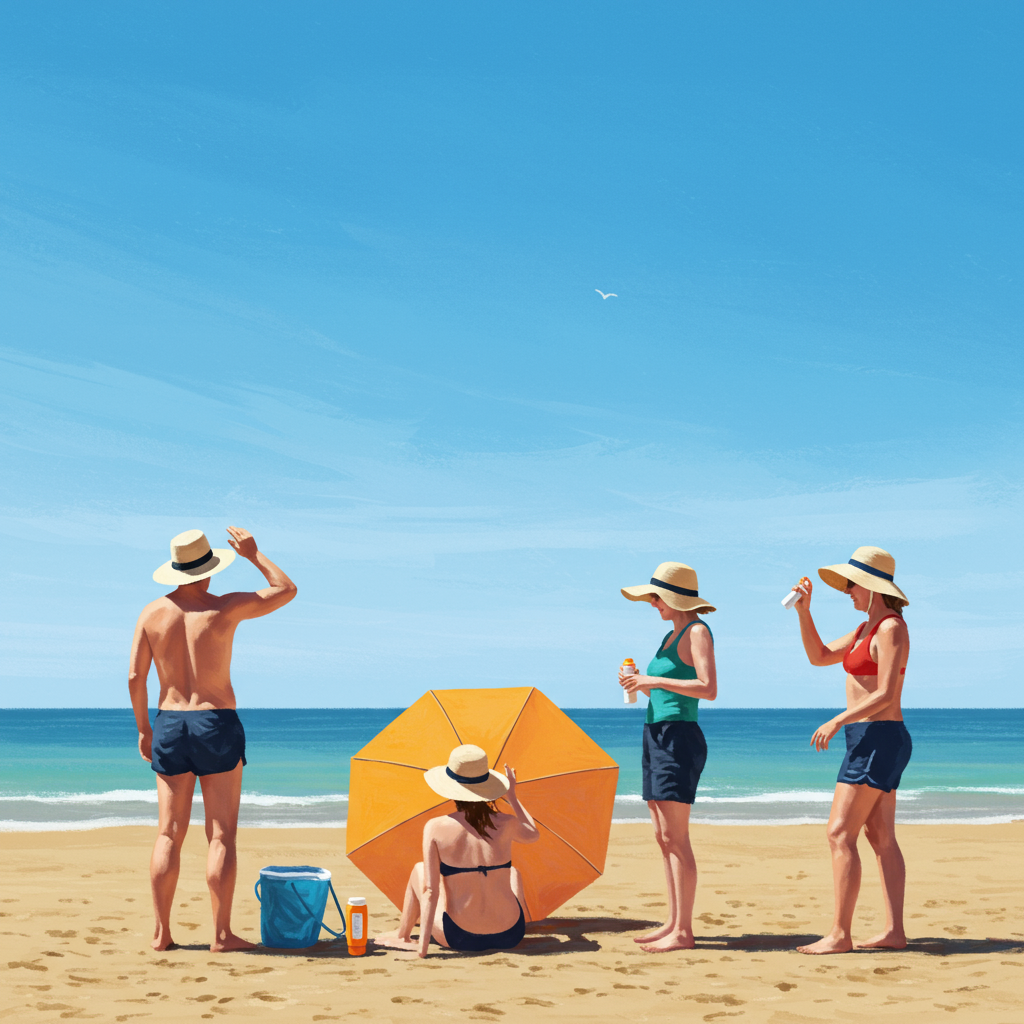Guernsey’s beautiful coastlines and sunny days invite residents and visitors outdoors, but enjoying the sunshine comes with significant health considerations, particularly concerning skin cancer risk. How deeply ingrained is sun protection within the island’s everyday culture? While awareness is certainly present, the degree to which sun safety is a fundamental habit appears to vary widely. This situation sparks debate between individual responsibility and the need for broader public health initiatives.
Comparing Sun Safety Attitudes: Guernsey vs. Australia
Spending two decades growing up in Guernsey before moving to Australia offered Megan Chapple a powerful perspective on differing sun safety cultures. She observed a distinct shift in her own habits. In Guernsey, applying suncream often felt like an afterthought, if it occurred at all. However, upon arriving in Australia, sun protection quickly became second nature. She describes it as essential as packing a towel or swimwear for a beach trip.
Megan attributes Australia’s prevalent sun-safe behaviour partly to higher sun exposure but strongly emphasizes a deliberate cultural and governmental push. She highlights specific initiatives that embed protection into daily life. These include the availability of free suncream at popular beach spots and even tax deductions allowing people to claim rebates on sun protection costs. Megan feels the Australian government actively encourages and promotes awareness, a contrast she felt keenly compared to her experience often leaving the house without protection while living on Guernsey.
Diverse Perspectives Among Islanders
The question of Guernsey’s sun-consciousness elicits varied responses from other residents. Joey Barling acknowledges her attitude has evolved over time. A decade ago, she admits sun protection wasn’t something she prioritized. However, becoming a mother significantly increased her awareness and vigilance regarding sun safety. She attributes this change partially to greater discussion and information available through community channels and media. Despite her personal shift, Mrs. Barling believes Guernsey’s overall culture isn’t optimally sun-safe. She suggests more visible efforts could significantly boost public awareness across the island.
Hilda offers a different, more proactive viewpoint. She integrates sun protection into her daily routine year-round. Hilda applies suncream every day, even during winter months, based on advice from her doctor. This highlights how personal health guidance can deeply influence individual habits.
Conversely, Keith Mansell views sun safety largely as a matter of personal choice. During a spontaneous trip to Pembroke beach, he hadn’t brought any suncream. He expresses reluctance towards feeling “nannied” about such decisions. Mr. Mansell believes sufficient information about sun risks and protection methods is readily available through newspapers and television. Therefore, he concludes, individuals have the necessary awareness to make their own informed decisions about using sun protection.
The Urgency of Skin Cancer Risk in Islands
This discussion about cultural attitudes towards sun safety carries significant weight due to concerning health statistics. Reports indicate that islands like Guernsey face notably high rates of skin cancer. Excessive exposure to ultraviolet (UV) radiation is a primary cause of most skin cancers. This reality underscores the critical importance of consistent, effective sun protection measures. The elevated risk transforms the conversation from a mere personal preference into a vital public health imperative for the island community.
Guernsey’s Proactive Sun Safety Initiatives
Despite varying individual habits, significant efforts are underway within Guernsey to enhance the island’s sun safety culture and directly address the risk of skin cancer. The charity Male Uprising Guernsey (MUG) plays a leading role in this. MUG actively collaborates with entities like Public Health and the Health Care Group. Their joint mission focuses on raising crucial awareness regarding both the prevention of skin cancers and their early detection, which is vital for successful treatment.
MUG has spearheaded practical initiatives, notably sponsoring widespread suncream distribution. Sun protection supplies have been provided to over 25 locations across Guernsey. These include primary schools, helping embed habits early, and major public events like The Big Gig, reaching wider audiences. Tony Tostevin from MUG stresses the necessity of sun safety education spanning from childhood through adulthood. This education includes teaching people not only how to protect themselves but also what signs to look for on their skin.
Schools across Guernsey are particularly active environments for fostering sun-safe behaviours. Vale Primary School, for instance, has achieved ‘sun safe’ accreditation from MUG. This involved implementing comprehensive policies designed to protect students. Teacher Juliet Bell emphasizes the positive impact of making suncream readily available at school. Vale Primary ensures shaded areas and water are accessible during outdoor activities and school trips. A clear sun hat policy is enforced, requiring students without hats to remain in shaded zones. Pupils are encouraged to apply suncream before arriving at school and to reapply it during breaks. They are specifically taught to take protective measures when UV levels reach three or higher.
All educational institutions in Guernsey adhere to the States of Guernsey’s Sun Safe Policy. This policy is considered the baseline expectation for sun safety. Many schools build upon this foundation with stricter rules. Examples include La Mare De Carteret and St Martins Primary Schools, which have long-standing policies making hats compulsory outdoors.
Secondary schools are also embracing innovative approaches. St Sampson’s High School has established a dedicated student sun safety team. These student monitors offer free suncream to peers during break and lunchtimes. They also provide helpful sun safety advice, peer-to-peer. Lee Thomas, subject lead for personal development at St Sampson’s, notes the “awful” statistics regarding skin cancer rates in Guernsey as a key motivator. He believes using student peer educators is particularly effective. This initiative arose from collaborative efforts among personal development teams across the island’s secondary schools. Young monitors like 11-year-old Jeorgie are often personally motivated by connections to cancer, adding a layer of genuine commitment.
Community partners further strengthen these efforts. The Channel Islands Coop sponsors suncream for numerous school trips. They also provide additional bottles for classroom use, ensuring access is maintained. Rajesh Amin, superintendent pharmacist at the Co op Pharmacy Guernsey, highlights the critical importance of protecting the entire community, emphasizing its particular relevance in Guernsey. These widespread initiatives demonstrate a concerted commitment from charities, public health bodies, educators, and local businesses. They aim to combat skin cancer risks by making protection accessible and fostering embedded habits from a young age, directly responding to concerning local health data.
Practical Steps for Staying Sun Safe in Guernsey
Regardless of official policies or cultural norms, individuals living in or visiting Guernsey can easily adopt simple, effective habits to protect themselves from harmful UV radiation. Monitoring the daily UV index is a critical first step; protection is needed when levels reach three or higher. Generously apply a broad-spectrum sunscreen with SPF 30 or ideally SPF 50+. Remember to reapply sunscreen at least every two hours, more frequently if swimming or sweating.
Seek shade during the sun’s peak intensity hours, typically between 11 am and 3 pm. Wearing protective clothing offers another layer of defence. Opt for tightly woven fabrics, wide-brimmed hats that shade the face, neck, and ears, and sunglasses that provide UV protection. It is vital to teach children these practices early to establish lifelong healthy habits. Be aware that UV rays can penetrate clouds and reflect off surfaces like sand, water, and even snow, increasing exposure. Integrating these measures makes sun safety a consistent and non-negotiable part of outdoor life.
The Ongoing Balance: Personal Choice vs. Collective Health
Guernsey’s dialogue around sun safety mirrors a broader societal tension between individual autonomy and the collective responsibility for public health. The varied perspectives highlight this ongoing debate. While some residents staunchly defend the idea that sun protection is a purely personal decision informed by widely available information, others argue that given the significant health risks, a stronger cultural emphasis and more pervasive public health “push” are necessary. Awareness campaigns, school policies, and community initiatives represent tangible steps towards cultivating a more universally conscious culture regarding sun exposure. However, successfully shifting ingrained habits and ensuring everyone prioritizes protection against concerning local skin cancer rates remains an active challenge requiring continued focus and engagement.
Frequently Asked Questions
How sun-conscious is Guernsey’s culture currently?
Guernsey shows a mixed level of sun-consciousness. While many residents, particularly parents or those receiving medical advice, are becoming more aware and adopting protective habits, others still view sun safety primarily as a personal choice. Compared to places like Australia, which have a strong governmental and cultural push, Guernsey’s overall ingrained sun-safe behaviour could be further enhanced through ongoing community efforts.
What initiatives are promoting sun safety in Guernsey?
Several organizations and institutions in Guernsey are actively boosting sun safety. Male Uprising Guernsey (MUG), in collaboration with Public Health, distributes free suncream at numerous locations and events. Schools play a key role, with institutions like Vale Primary achieving accreditation and implementing policies like mandatory hats and providing suncream. Secondary schools use student-led teams. The States of Guernsey provides a baseline policy for all schools, often exceeded locally. The Channel Islands Coop also supports schools with suncream supplies.
What are key ways Guernsey residents can stay sun safe?
Residents can adopt several critical habits. Always check the UV index and protect skin when it reaches three or higher. Apply broad-spectrum SPF 30+ (ideally 50+) sunscreen liberally and reapply frequently, especially after water or sweating. Seek shade during peak sun hours (11 am-3 pm). Wear protective clothing, including wide-brimmed hats and UV-protective sunglasses. Teach these practices to children early to build consistent habits.
Conclusion
Guernsey’s journey towards fully embedding sun safety within its culture is clearly in progress. The island benefits from dedicated organizations and educational institutions actively working to raise awareness and provide practical resources like free suncream. While individual attitudes vary – from daily vigilance based on medical advice to a view emphasizing personal choice – the underlying concern over reported high skin cancer rates provides a compelling reason for continued collective action. Fostering a culture where consistent sun protection becomes a natural, unquestioned habit for everyone on the island remains a crucial goal for safeguarding community health against the undeniable risks of UV exposure.
Word Count Check: 1180



